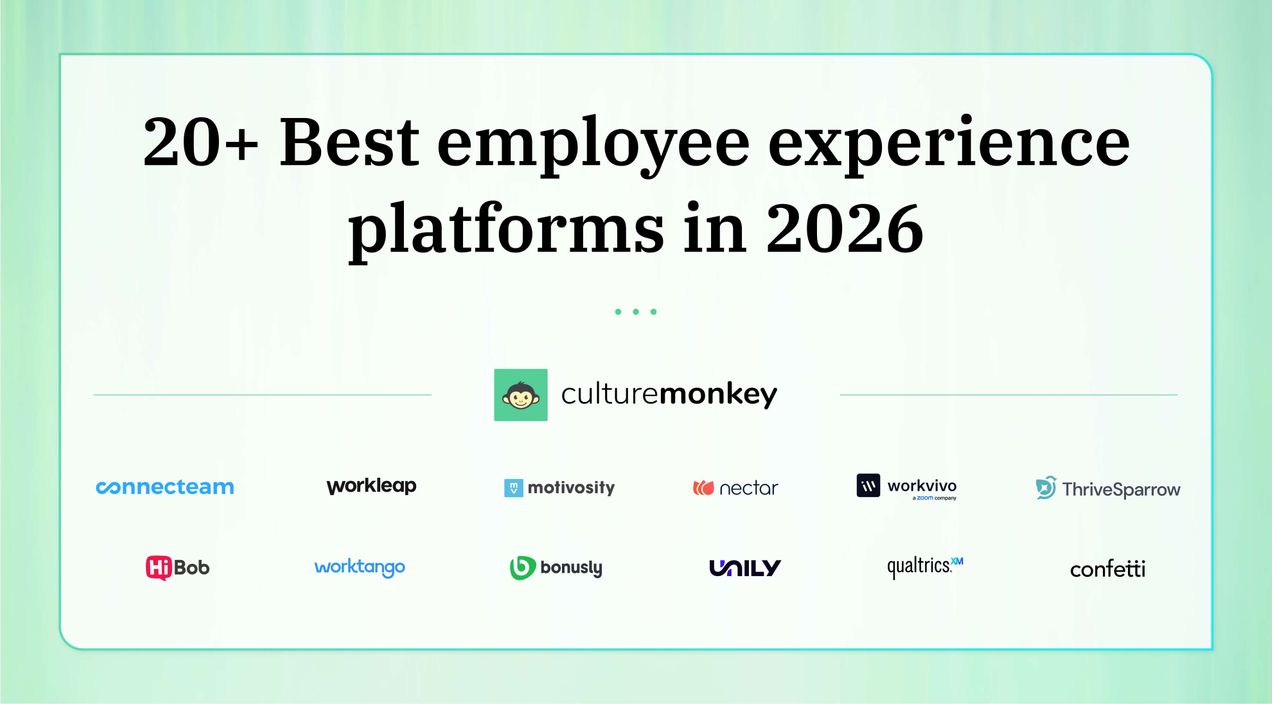Employee concern in the workplace: Top reasons and how to combat them in 2024

Employee concerns are an inevitable aspect of any work environment. These concerns can range from minor frustrations with office procedures to more serious issues like workplace harassment or safety violations.
Regardless of the nature of the concern, organizations must establish effective mechanisms for employees to voice their issues and feel confident that their concerns will be addressed fairly and constructively.
A failure to address employee concerns can have a significant detrimental impact on an organization. Data shows that Mental health issues cost the global economy around $1 trillion every year. Unheard and unresolved concerns can lead to decreased employee morale, reduced productivity, and increased turnover.
In the following sections of this blog, we will explore the various types of employee concerns that may arise in the workplace. We will discuss the importance of establishing a culture of clear understanding and open communication and provide practical strategies for organizations to develop effective systems for addressing employee concerns.
What is an employee concern?

An employee concern refers to any issue or problem that an employee experiences or perceives within their workplace environment.
These are the most common employee concerns and can range from personal grievances to broader systemic issues affecting multiple employees.
Common employee concerns include workplace safety, unfair treatment, discrimination, harassment, workload issues, lack of career development opportunities, communication problems, and conflicts with colleagues or managers.
Workplace safety concerns focus on physical hazards, inadequate equipment, or insufficient safety protocols that endanger employees' well-being. These issues are critical as they directly impact employee health and productivity. Data shows that Around 1 in 6 people experience mental health problems in the workplace.
On the other hand, unfair treatment encompasses instances of favoritism, bias in promotions, or unequal distribution of workload, factors that can lead to dissatisfaction and demotivation among employees. Addressing these concerns fosters a fair and equitable work environment.
Why do employee concerns affect productivity?

Employee concerns directly impact productivity due to their effect on morale, motivation, and focus within the workplace. When employees experience issues such as safety hazards, violence, unfair treatment, discrimination, or inadequate career development opportunities, it can lead to decreased job satisfaction and a sense of disengagement.
Unresolved safety concerns create anxiety and distraction, hindering employees' ability to concentrate on their tasks. Plus, unfair treatment or discrimination complaints can foster resentment and a lack of trust in the organization, reducing teamwork and collaboration.
Employees may also feel demotivated to perform at their best when they perceive inequities in promotions or workload distribution.
Moreover, concerns about career development and training opportunities can lead to stagnation and a lack of skill growth, affecting long-term productivity and innovation.
Addressing employee concerns is crucial for maintaining high levels of motivation, employee engagement and, and focus, which are essential for achieving organizational goals and sustaining productivity over time.
How to identify employee concerns?

Identifying employee concerns requires attentive observation, open communication channels, and proactive engagement with staff:
- Regular one-on-one meetings between managers and employees can provide a platform for discussing personal and professional challenges. These meetings allow managers to listen actively to employees' feedback, concerns, and suggestions.
- Anonymous surveys and feedback mechanisms can help uncover broader issues affecting multiple employees. These tools allow employees to express their thoughts honestly without fear of reprisal, offering insights into areas such as workplace culture, job satisfaction, and perceived fairness.
- Observing changes in employee behavior, such as decreased productivity, increased absenteeism, or signs of stress, can indicate underlying business concerns. Managers should be attentive to these indicators and initiate conversations to understand the root causes.
- Creating a supportive and transparent workplace culture encourages employees to voice their concerns openly. This includes fostering a culture of trust, where employees feel safe to discuss issues without judgment.
The top 10 employee concerns

The top 10 employee concerns can vary based on industry, company culture, and each person and individual experiences, but common themes include:
- Workplace safety: Employees prioritize physical safety (e.g., ergonomic workstations, safety protocols) and emotional safety (e.g., freedom from harassment). Addressing these concerns involves regular safety audits, providing necessary training, and fostering a culture where safety is a top priority.
- Fair compensation: Beyond base pay, concerns include benefits, bonuses, and raises. Transparency about compensation structures, conducting regular market reviews, and offering performance-based incentives can mitigate these concerns.
- Career development: Opportunities for growth, training, and advancement are crucial. Providing clear career paths, mentorship programs, and continuous learning opportunities helps retain talent and foster employee loyalty.
- Workload: Balancing workload to prevent burnout is essential. Regular workload assessments, efficient task allocation, and promoting work-life balance initiatives (e.g., flexible scheduling) can alleviate these concerns.
- Communication: Clear, open, and honest communication from management promotes trust and alignment. Regular town halls, feedback mechanisms, and accessible leadership enhance organizational transparency.
- Recognition and appreciation: Employees value recognition for their contributions. Implementing formal recognition programs, celebrating achievements publicly, and providing constructive feedback regularly boost morale and motivation.
- Workplace culture: A positive culture fosters collaboration, respect, and inclusivity. Defining and reinforcing core values, promoting diversity, equity, and inclusion (DEI) initiatives, and addressing toxic behaviors ensure a supportive work environment.
- Job security: Concerns about layoffs, restructuring, or job instability require transparent communication and strategic planning. Sharing organizational goals, and performance metrics, and offering career transition support can reassure employees.
- Work-life balance: Supporting employees in managing personal and professional responsibilities is crucial. Around 828,000 employees suffer from work-related stress, depression, or anxiety every year. Therefore, offering flexible work arrangements, promoting wellness programs, and encouraging unplugged time off foster a healthy work-life balance.
- Managerial support: Accessible, empathetic, and skilled managers play a pivotal role. Investing in leadership development, fostering open-door policies, and providing managerial support resources help build strong relationships and trust within teams.
How to address employee concerns in the workplace?
More than half (52%) of employees don’t feel they get enough support from their employer for their mental well-being. So, addressing employee concerns is crucial and begins with creating open lines of communication and fostering a supportive environment.
Establish regular opportunities for employees to voice their concerns, such as through one-on-one meetings, team meetings, or anonymous feedback channels. Actively listen to their feedback without judgment, demonstrating empathy and a willingness to understand their perspectives.
Prioritize transparency in communication regarding company policies, decisions, and changes. Clear communication helps manage expectations and build trust among employees.
You should also take prompt action to address identified concerns. Whether it involves resolving safety issues, reviewing compensation structures, providing career development opportunities, or improving workload management, demonstrate a commitment to improving the workplace based on employee feedback.
Lastly, empower managers and supervisors with the skills and human resources to support their teams effectively. Training in conflict resolution, communication, and leadership can enhance their ability to address concerns promptly and constructively.
How do you document employee concerns?

Documenting employee concerns systematically is crucial for maintaining transparency, tracking progress, and ensuring accountability. Here’s a structured approach:
- Create a standard form or template: Develop a standardized form or template specifically for documenting employee concerns. This form should include fields for details such as the employee’s name, date of concern, nature of the concern, and any relevant details or specifics provided by the employee.
- Record details clearly and objectively: When documenting concerns, ensure clarity and objectivity. Record the concern in the employee’s own words whenever possible, noting key points and any supporting information provided.
- Include relevant context: Document any context surrounding the concern, such as previous incidents, interactions, or related policies. This provides a complete picture for understanding the issue.
- Note actions taken: Record any actions taken or decisions made in response to the concern. Include dates, names of individuals involved, and outcomes of any investigations or resolutions.
- Maintain confidentiality: Ensure that documentation is kept confidential and accessible only to authorized personnel involved in addressing the concern. Respect privacy and comply with data protection regulations.
- Follow-up and review: Schedule follow-up reviews to track progress on addressing the concern. Update the documentation with any developments or changes in status.
- Use electronic systems where possible: Utilize electronic systems or databases for storing and managing documentation securely. This facilitates easy access, retrieval, and updating of information as needed.
Role of anonymous employee survey tool in identifying employee concerns in the workplace

Anonymous employee survey tools play a crucial role in identifying employee concerns by providing a confidential platform for honest feedback. These tools allow employees to express their opinions, grievances, and suggestions without fear of reprisal, which is especially important for sensitive or contentious issues.
By ensuring anonymity, these surveys encourage participation from a broader spectrum of employees, including those who might otherwise hesitate to speak up.
Anonymous surveys provide quantitative data that can highlight trends and patterns across the organization. They help identify common themes such as concerns about workplace culture, communication gaps, dissatisfaction with management practices, or specific issues like harassment or discrimination.
This data is invaluable for pinpointing areas needing improvement and prioritizing actions to address employee concerns effectively. Survey results can serve as a baseline for measuring progress over time and evaluating the impact of future interventions or policy changes.
By leveraging anonymous employee survey tools, organizations can gather comprehensive insights, promote transparency, and demonstrate a commitment to listening to their workforce.
Conclusion
Addressing employee concerns is pivotal for fostering a productive and supportive environment. By implementing strategies such as regular communication channels, transparent policies, and proactive issue resolution, organizations can enhance employee satisfaction and engagement.
Tools like CultureMonkey's anonymous feedback platform play a crucial role in this process, offering a confidential space for employees to voice their opinions openly. Leveraging CultureMonkey enables companies to gather actionable insights, promote transparency, and drive meaningful improvements based on direct employee feedback.
Embracing employee survey tools not only strengthens organizational culture but also empowers employees to contribute positively to company success.
FAQs
1. How often should employee concerns be addressed?
Addressing employee concerns should be a continuous process. Regular check-ins through surveys, meetings, and feedback sessions help keep a pulse on employee sentiments. Major concerns should be addressed promptly, while ongoing communication ensures that smaller issues are not overlooked, fostering a proactive approach to maintaining a positive workplace environment.
2. What if an employee doesn't feel comfortable using feedback tools?
Hesitant to use employee feedback tools can be encouraged through clear communication about the tool's purpose and confidentiality measures. Providing alternative channels for feedback, such as confidential meetings with the department, HR, or management, ensures all employees have a comfortable way to express their concerns.
3. How can managers balance confidentiality with the need to address employee concerns openly?
Managers can maintain confidentiality by aggregating survey data to identify trends without revealing individual responses. When addressing concerns openly, focus on general themes and solutions rather than specific details. This approach respects privacy while fostering a transparent dialogue about improving the workplace.
4. What if employee concerns are persistent despite efforts to address them?
Persistent concerns may indicate underlying systemic issues. Conducting deeper investigations, involving relevant stakeholders, and revisiting policies or procedures may be necessary. Continuous monitoring and reassessment ensure that solutions are effective and that employees see tangible improvements over time.
5. How can small businesses with limited resources effectively address employee concerns?
Small businesses can prioritize open communication and personal interactions. Regular team meetings, individual check-ins with employees, and using affordable or free survey tools like CultureMonkey can gather and respond to feedback effectively. Focus on transparent decision-making and fostering a supportive culture to address concerns within resource constraints.



